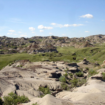Radon gas a danger to lung health
By Cal Braid - Lethbridge Herald Local Journalism Initiative Reporter on November 26, 2022.
According to Health Canada, radon is the number one cause of lung cancer in non-smokers, and it’s present in almost everyone’s home.
Radon is a radioactive gas, released during the breakdown of uranium in soil and rock. It’s invisible, odourless, and tasteless, and therefore physically undetectable. While it doesn’t pose the immediate danger of a gas like carbon monoxide, when it accumulates in higher levels indoors, it can be dangerous over the long term. The risk of cancer depends on the level and duration of exposure to radon in levels in excess of 200 becquerels per cubic meter (bq/m3).
Madison Pecoskie, regional radiation specialist with Health Canada said, “In the Chinook Regional Health Authority, the percentage of homes that are likely to have high levels of radon is 8.9 per cent. The only way you know if you have high levels of radon is to test. Two houses can be built side by side and one of the homes can have over 200 bq/m3 and the home right next door could have under 200 bq/m3,” which are the standards laid out in the Candian guidelines for radon accumulation.
“The risk of radon exposure depends on three different things: the level of radon that you are exposed to, the length of time that you are exposed, and your smoking habits,” Pecoskie said. “Smokers or previous smokers have a higher risk of health problems from radon. The only known health risk from radon is lung cancer.”
“Testing for radon is really easy,” she said. “You can order a do-it-yourself test kit, or you can hire a measurement professional. The important thing that Health Canada recommends is that you order a long-term test kit-long term being at least three months-because the radon levels can fluctuate.” She said it’s also recommended to test in the fall or winter, when the windows stay closed for months on end.
If a home is found to be exceeding those levels, she said that Health Canada suggests using someone with the Canadian-National Radon Proficiency Program for mitigation.
“It’s quite a quick process. It’s called active soil depressurization,” Pecoskie said. “Basically what is involved is installing a pipe through the foundation floor slab and attaching a fan to it that will run continuously. It draws the radon gas out from below and vents it out the side of your home. Once it mixes with fresh outdoor air, the levels dissipate and it’s not of concern.”
Radon gas breaks down to form radioactive elements and when inhaled, it continues to break down in the lungs, creating radioactive particles that release small bursts of energy. The bursts of energy absorbed by nearby lung tissue can damage the lung cells. When cells are damaged, they have the potential to result in cancer when they reproduce.
“Radon can enter a home any place it finds an opening where the house contacts the ground: cracks in the foundation, floor, walls, construction joints, gaps around service pipes, support posts, window casements, floor drains, sumps, or cavities inside walls,” according to Health Canada.
For more information, visit takeactiononradon.ca or find a local certified professional at c-nrpp.ca
11-10




